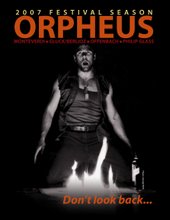Gluck Discussion Panel
What does it take to put on an opera? What sort of research is done? Over 150 people were asking themselves the same questions today at noon, when the first of 4 panel discussions were held in Alice Busch Opera Theater (ABOT). At the helm were seven members of the production team for Berlioz’ edition of Gluck's Orphée et Eurydice, all integral components of the planning, rehearsal, and performance stages of a performance. The panel included, from left to right, Kelley Rourke (Dramaturgy/Projected Titles), who moderated the discussion, Lillian Groag (Director), Nicola Bowie (Choreographer), Julian Wachner (Conductor), Robert Wierzel (Lighting), Constance Hoffman (Costumes), and John Conklin(Set).
In planning the production, Director Lillian Groag focused on not just the story of a man, but the story of how a community deals with death—in this case, a community in the 18th century. An understanding of Gluck’s cultural context helps explain the alterations he made from the original myth, mainly, that Eurydice is resurrected a second time. As a German Lutheran, Gluck's belief in redemption would have been a central tenet of his faith. Resurrection and rebirth is a central theme in Christian literature, from the raising of Lazarus to the resurrection of Jesus. Gluck was also living at the crux of the Enlightenment, a time when human invention and intelligence were held to the highest standard. “To send the audience home depressed would be a highly illogical decision,” quipped Groag; rationality had to prevail, as was the style of the time.
Conductor Julian Wachner said that cultural surroundings played a significant role in the music as well; Gluck was working right in between the Baroque and Classical periods. Wachner called the piece “a watershed event [in that] musical expression could be connected to everyday life”. This opera unfolds in real time, meaning a character does not have a six minute aria to portray one emotion. They only have as much time as we do—sometimes mere seconds—to show the world what they are feeling. Wachner also touched on which aspects of the show were altered by composer Hector Berlioz. Keeping the libretto in French, Berlioz reworked the piece less than one might presume. He did, however, create an orchestration that substituted modern instruments for those no long longer in existence, with careful attention to creating a more Baroque sound. He also transposed the role of Orpheus, which already existed in versions for castrato and haut-contre, to a mezzo-soprano. This, of course, required a few key changes. Wachner confessed that he, along with the whole production team, has been “swimming in the love of the music”.
Choreographer Nicola Bowie brings movement in all forms into both earth and the underworld. Although Bowie worked closely with all members of the cast, it was Trey Gillen and Katarzyna Skarpetowska who were a large part of her focus in the rehearsal process. Trained at The Julliard School, both dancers play the roles of instigators, guides, storytellers, as well as a constant reminder of death and its presence in our lives. Their transformation scene by scene, as well as that of the chorus, is overwhelmingly impressive and like a good lighting plot or set design, instantly pulls the audience into the moment.
Since this production just started rehearsing in the theatre this week (their rehearsal space up until now has been off campus), many elements of production including sets, costumes, and lighting were only recently added. This panel discussion allowed the designers to shed some light on their individual and collective inspiration. John Conklin, who designed the set, rooted his inspiration in the spirit of the 18th century, and, like Groag, wanted to connect the audience to the urgency and universality of the story. Conklin tapped into the work of two period artists, Francisco Goya (1746- 1828) and Giovanni Piranesi (1720-1778). In these artists’ depictions, Rome’s fall had left behind countless grandiose ruins and fallen architecture. The people of the time used what they could, by taking pieces and using them as building materials, or squatting in the rooms of crumbling palaces. Conklin used this theme of “melancholy in lost grandeur of a classical world” and allowed his set a pastoral element while still remaining aware of the outside world and its influences.
Costume designer Constance Hoffman was also drawn to Goya; her goal was to make sure the person wearing the costume was the focus and not the other way around. Simple, breathable clothes made from modest materials like linen and cotton allow the singers to portray different characters over the course of the opera.
Light designer Robert Wierzel focused on creating a singular mood for each scene. The lights give the audience an instant hint to the scene they are about to walk, writhe, or dance into. Wierzel also added that one of the advantages of working at the Glimmerglass Opera is having the time to experiment in the space through the whole summer. And considering that Gluck opens in two weeks, it is incredible to think that the performers and designers already have a chance to put the piece together on stage.

